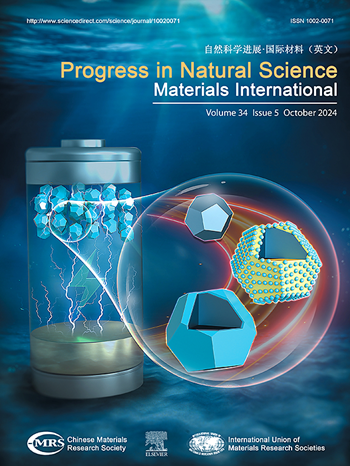微囊化聚磷酸铵对聚氯乙烯的阻燃抑烟性能
IF 7.1
2区 材料科学
Q2 MATERIALS SCIENCE, MULTIDISCIPLINARY
Progress in Natural Science: Materials International
Pub Date : 2025-08-01
DOI:10.1016/j.pnsc.2025.05.005
引用次数: 0
摘要
本研究以磷酸腈氯三聚体(HCCP)和对苯二胺(PPD)为原料,通过聚合制备网状化合物HP-DP,并将聚磷酸铵(APP)微胶囊化制成阻燃剂APP@HP-DP,再将其掺入聚氯乙烯(PVC)中制备PVC复合材料。在PVC复合材料中加入APP@HP-DP阻燃剂,提高了PVC复合材料的产碳率和热稳定性,使复合材料的LOI由23.1%提高到28.6%。与原始PVC复合材料相比,在9.5 wt% APP@HP-DP的情况下,峰值热释放率(PHRR)和峰值产烟率(PSPR)分别下降了47.2%和23.2%。力学性能试验表明,添加APP@HP-DP后PVC复合材料的抗拉强度和断裂伸长率没有变化。因此,在PVC复合材料中加入APP@HP-DP,在不影响其机械性能的情况下,显著提高了其阻燃性和抑烟性,可有效降低火灾的潜在危险。本文章由计算机程序翻译,如有差异,请以英文原文为准。
Flame retardant and smoke inhibition properties of microencapsulated ammonium polyphosphate on polyvinyl chloride
In this study, a network compound (HP-DP) was produced by polymerization of phosphonitrilic chloride trimer (HCCP) and p-phenylenediamine (PPD), and microencapsulated ammonium polyphosphate (APP) to create flame-retardant APP@HP-DP, which was then incorporated into polyvinyl chloride (PVC) to prepare PVC composites. Adding APP@HP-DP flame retardant to PVC composites enhanced carbon yield, thermal stability and increased LOI of the composites from 23.1 % to 28.6 %. With 9.5 wt% APP@HP-DP, the peak heat release rate (PHRR) and peak smoke production rate (PSPR) dropped by 47.2 % and 23.2 %, respectively, compared to the original PVC composite. Mechanical property tests showed no change in tensile strength or elongation at the break for PVC composites with APP@HP-DP addition. Therefore, the addition of APP@HP-DP to PVC composites has significantly improved its flame retardancy and smoke suppression without affecting its mechanical properties, which can effectively reduce the potential danger of fire.
求助全文
通过发布文献求助,成功后即可免费获取论文全文。
去求助
来源期刊
CiteScore
8.60
自引率
2.10%
发文量
2812
审稿时长
49 days
期刊介绍:
Progress in Natural Science: Materials International provides scientists and engineers throughout the world with a central vehicle for the exchange and dissemination of basic theoretical studies and applied research of advanced materials. The emphasis is placed on original research, both analytical and experimental, which is of permanent interest to engineers and scientists, covering all aspects of new materials and technologies, such as, energy and environmental materials; advanced structural materials; advanced transportation materials, functional and electronic materials; nano-scale and amorphous materials; health and biological materials; materials modeling and simulation; materials characterization; and so on. The latest research achievements and innovative papers in basic theoretical studies and applied research of material science will be carefully selected and promptly reported. Thus, the aim of this Journal is to serve the global materials science and technology community with the latest research findings.
As a service to readers, an international bibliography of recent publications in advanced materials is published bimonthly.

 求助内容:
求助内容: 应助结果提醒方式:
应助结果提醒方式:


